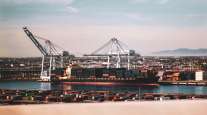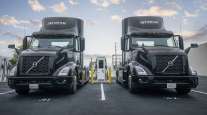Senior Reporter
SoCal Ports Approve Aggressive Air Quality Rules for Moving Cargo

The ports of Los Angeles and Long Beach announced they have approved the 2017 Clean Air Action Plan Update that sets out aggressive clean air strategies for moving cargo through the nation’s busiest container port complex — which is on pace for its busiest year ever.
“These new policies and strategies are some of the most progressive air-quality rules in the nation,” Long Beach Mayor Robert Garcia said in a statement.
San Pedro Bay Ports CAAP 2017 Update unanimously approved by #PortofLA and @portoflongbeach governing boards. pic.twitter.com/9jPD2h1PnW — Port of Los Angeles (@PortofLA) November 2, 2017
“We are serious about fighting climate change, protecting local residents and promoting economic success at our ports.”
The` initiatives include new investments in clean technology, expanded use of alternatives for reducing at-berth ship emissions and a demonstration of up to 100 zero-emission trucks in the next few years, according to the plan.
Despite these initiatives, the Teamsters said the plan fell short, especially its Clean Truck Program.

Potter
“The industry model is to force the costs of truck operation and any new technology onto the drivers. Such an approach is simply not sustainable and ultimately undercuts the goal of improving and maintaining air quality,” Teamsters Port Division Director Fred Potter said of the plan before it was approved.
How to fund the shift to cleaner trucks is a question that remains unresolved, said Phillip Sanfield, director of media relations for the Port of Los Angeles.
“We are aggressively going after any source of funding possible. We are going to be helping to some degree, but the cost of this is going to have to be spread out and borne by a lot of different parties — government agencies, ports, private agencies, to the trucking companies themselves. The devil definitely is in the details. There is no easy solution to that,” Sanfield said.
The details will come into play in the weeks, months and years ahead, he said.
The Teamsters also called for a more aggressive timetable for “sun-setting” old trucks, and for the ports to inspect trucks for safety and air emissions, among other recommendations.
One fleet executive questioned the need for the plan at all.
“I am honestly appalled that something like this is going through,” said Peter Schneider, executive vice president for T.G.S. Transportation Inc., a drayage firm based in Fresno, Calif. “I understand politics, but something that costs in the neighborhood of $14 billion with our ports costing more than any other port in the U.S. is just another way for East Coast and Gulf Coast ports to gain more market share. I am all for cleaning the air, but it has to be done in moderation and with technology that is affordable.”
T.G.S. bought new trucks in 2008 through 2010 for the first iteration of the ports’ action plan, Schneider said, and two more sets of new trucks since, and noted the trucks keep getting cleaner but more expensive.
“As a medium-sized business, we can afford them but only at certain rate levels. The average owner-operator cannot, and needs to buy a truck that is 4 to 5 years old in order to afford the payments. Unless rate levels go up 20-30% and every penny goes to the owner-operator, the industry cannot afford new trucks,” he said.
Other options include forcing terminals to turn to battery-electric yard tractors or to use cleaner diesel or natural gas engines in that equipment, he said.
Other drayage firms operating at the ports either did not reply to a request for comment or declined to comment on the plan or funding cleaner trucks.

Port of Los Angeles via YouTube
Also, beginning in 2020, the plan would require terminal operators to deploy zero-emission cargo-handling equipment, if feasible, or if not, then the cleanest available technology. The ports’ goal is to transition all terminal equipment to zero emissions by 2030.
Targets for reducing greenhouse gases from port-related sources to combat global warming and climate change are a new element of the 2017 plan.
The document calls for the ports to reduce GHG 40% below 1990 levels by 2030 and by 80% below by 2050.
The U.S. Environmental Protection Agency reported the majority of greenhouse gas emissions from transportation are related to carbon dioxide resulting from the combustion of petroleum-based products — they account for 27% of the total emitted from all sources.
Over the next six years, the ports aim to cut emissions of diesel particulate matter 77%, nitrogen oxides 59% and sulfur oxides 93% below 2005 levels. Intensifying efforts to reduce GHGs is expected to further lower diesel particulate matter, nitrogen oxide and sulfur oxide emissions.
The estimated cost of implementing the 2017 Clean Air Action Plan ranges from $7 billion to $14 billion.
The ports reported recent air-emission inventories show emissions are declining while cargo volumes are rising, confirming the ports are growing green.
The ports first adopted a Clean Air Action Plan in 2006.




